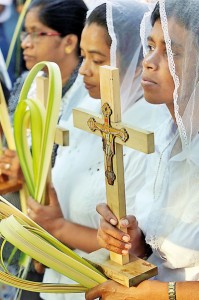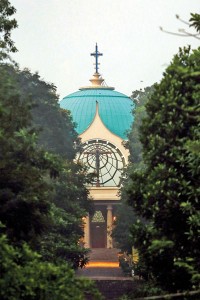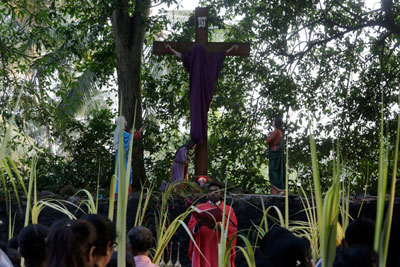Tewatte’s Easter miracle

Devotees in prayer on Palm Sunday
Heads bowed and palms together in devotion, the ‘Amens’ rise to a crescendo and fade away amidst the gentle shade cast by a thick canopy of rubber and mahogany trees, bird-calls and the tolling of a bell.
The devotees have gathered in their numbers, quite early for a Sunday morning, and the gok-kola blessing has been performed at a tiny old grotto now turned into ‘Calvary’, with the Palm Sunday mass being held close-by, once again in a not-too-big chapel.
It is close to noon that people waving gok-kola go in perahera to the one-and-only National Basilica in the country at Tewatte, Ragama, across the road from both the grotto and the chapel.
From Palm Sunday, Christians across the world including Sri Lanka step into the most important week in their calendar, the Holy Week, which ends today, Easter Sunday.
It is a week of intense sorrow and joy, where Christians closely follow the agony and passion of Jesus Christ, as He was welcomed by palm-waving crowds and hailed as king, only to be denigrated, scourged, spat on and adorned with a crown of thorns and crucified on Mount Calvary on Good Friday, to rise again on Easter Sunday, 2017 years ago.
Easter Sunday is of special significance for Tewatte. Seventy-five years ago, then Ceylon was very much at the centre of the arena of World War II, being strategically-placed in the Indian Ocean, facing double jeopardy as it harboured the British Eastern Fleet. On April 5, 1942, as men, women and children gathered in churches across the country, Japan’s Imperial Navy launched the Easter Sunday Raid or Battle of Ceylon on Colombo followed a few days later by another attack on Trincomalee.

The National Basilica with its bronze depiction of the ‘Dying Christ’ Pix by M.A. Pushpa Kumara
Many of the elderly devotees at Tewatte believe that the warring nations had not contended with divine intervention, for two years before, at the tiny grotto of Mary, the beloved mother of Christ, where last Sunday the gok-kola blessing took place, the then Archbishop of Colombo, Jean Marie Masson of the Oblates of Mary Immaculate (OMI), had pleaded with Our Lady on May 26, 1940 to save Ceylon from the ravages of war.
The Chapel to Our Lady of Lourdes at Tewatte, according to the Parish Priest and Administrator of the Tewatte Basilica and Shrine, Fr. Victor Jayamanne, originated in 1911 when a band of Catholics under the guidance of the then Ragama Parish Priest, Fr. A. Kieger OMI, established it under the Ragama Parish. Later in November 1917, nearly 100 years ago, Fr. A Collorec OMI had built the tiny grotto.
It is to this grotto that troubled and worried Archbishop Masson came from Colombo to lay down his fears and seek the favour of saving the nation. In return for the succour of Mary, he made a fervent promise or vow that he would build in her honour, a Votive Shrine for ‘Our Lady of Lanka’.
Ceylon did escape the ravages of war and the vow of the Votive Shrine was fulfilled by Cardinal Thomas Cooray OMI. (Incidentally, the order of the OMIs had been established soon after the French revolution to revive the spirit of faith among rural and industrial populations through devotion to the Sacred Heart of Jesus and Mary Immaculate.)

Fr. Victor Jayamanne
Tales abound even about the building of the Basilica, how the church had only a small block of land on which was located the chapel and the grotto. Bordering this land was Orange Hill, a huge rubber estate whose owner refused to sell it on the request of the church.
Once again, a vow had been made to Our Lady by Fr. Claude Lawrence OMI and the land owners had decided to sell Orange Hill to the church when for some mysterious reason, their rubber trees began to wither and die.
With the land in the possession of the church, the construction of the church building had begun, with Pope Paul VI endowing it with the title ‘Minor Basilica’ in 1973 and the work being concluded in 1974.
The consecration of the National Basilica took place on February 6, 1974 along with Mary being crowned as Our Lady of Lanka the same day.
It is not only to the chapel and the old grotto but the beautiful National Basilica that people come from far and wide, because miracles are said to take place here. A well by the side of the chapel is believed to have healing waters and many bathe here and even fill-up bottles to take back home with them.
Carrying her two-year-old son, Erandani Fonseka from Walpola close by, is praying with intent. Her little son’s shoes are on the ground, close to a bottle of water and she says she cannot sit because her son begins to cry.
Many people have brought their own chairs and while the chapel is crowded, many more, couples, families, singles, are scattered across the land surrounding it.
“Mata nam hariyata pihita thiyenawa,” smiles Erandani, whose husband is in the armed services, recalling a time not so long ago when their family was drowning in debt.
Her tearful prayers sent up with the smoke of numerous candles she lit at the grotto were answered when an unexpected loan was passed and they were able to overcome their dire financial straits.

Gok-kola blessing at the old grotto, now Calvary
Young husband and wife, Pradeep Sampath Kumara and Nadeesha Dharshini, speak of busloads of people arriving from all parts of the country. “The environment is peaceful and they camp here and take part in the services,” says Pradeep.
Seventy-year-old A.W.R. Gregory shakes his head vigorously in affirmation of miracles occurring here, while near him boys and girls are crafting crosses from the blessed gok-kola in remembrance of the crucifixion of Christ.
These gok-kola crosses will be reverently preserved in homes till next year’s Ash Wednesday comes around. Then the dried crosses will be set aflame and the ash used to mark a cross on the foreheads of the devotees, as the Season of Lent begins again.
This humble cross is the symbol of ultimate sacrifice and death and then the resurrection of Jesus Christ, giving hope to millions across Sri Lanka and the globe.


